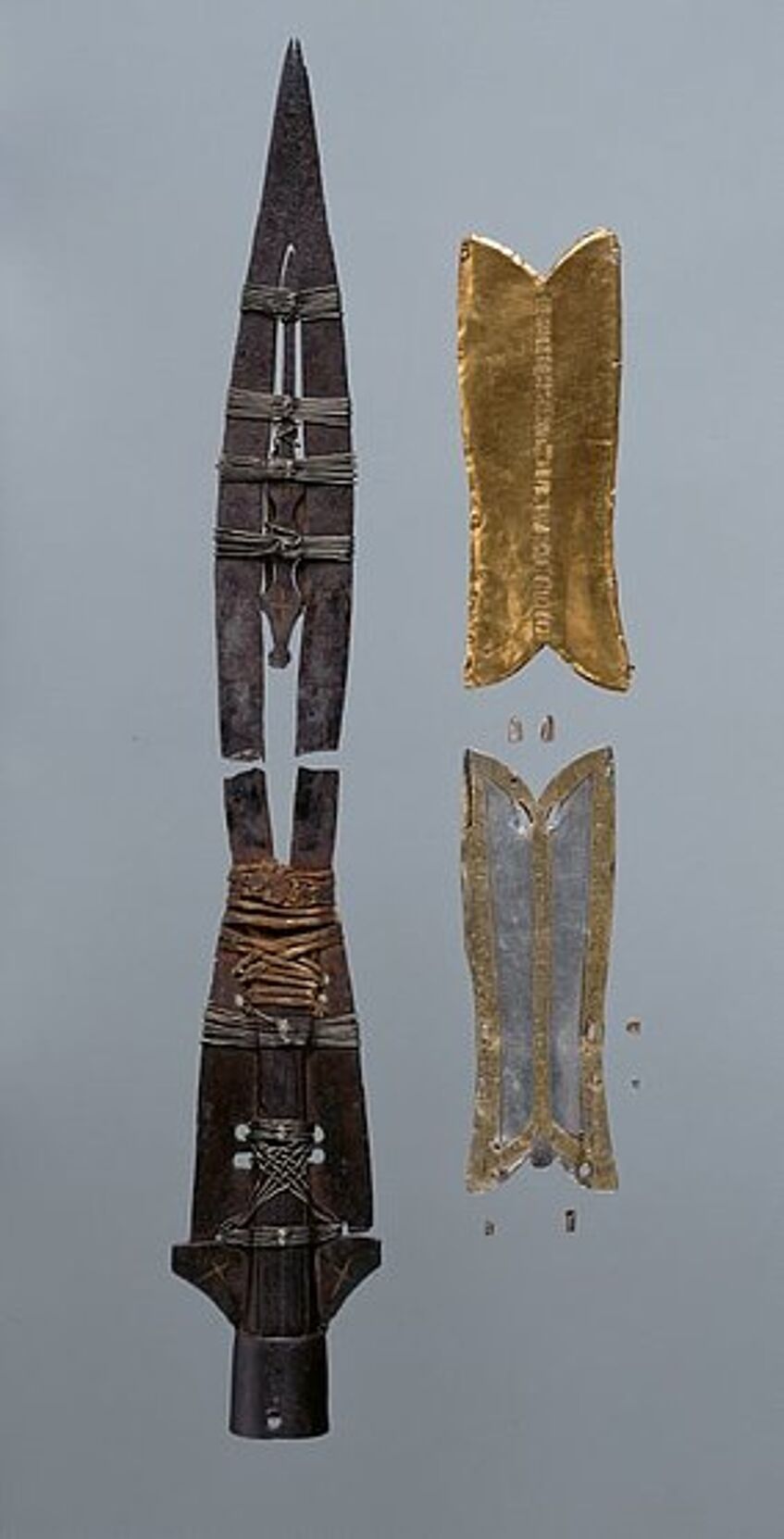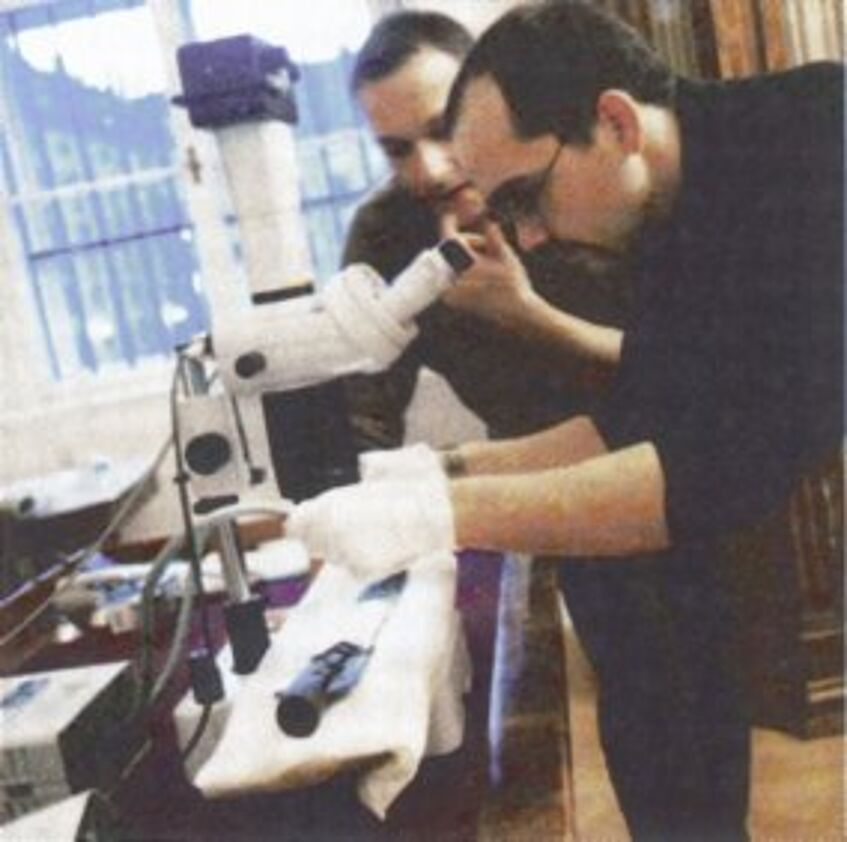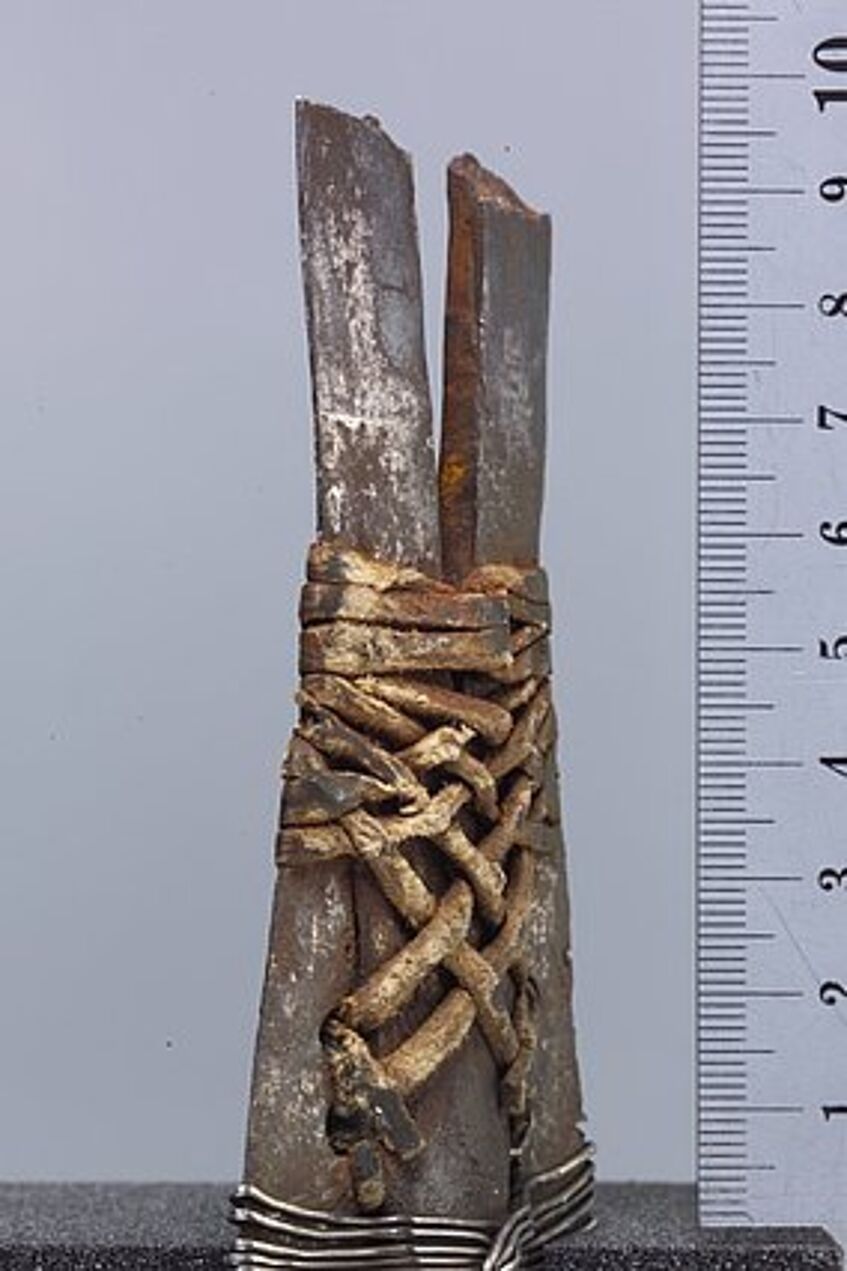The forging technique of the Holy Lance in the Treasury of the Kunsthistorisches Museum Wien, (PI. M. Mehofer)
Introduction
The Holy Lance, housed in the treasury of the Kunsthistorisches Museum Vienna, is an artifact of extraordinary archaeological and historical significance. The extensive body of literature dedicated to this lance highlights both its intrinsic importance and the fascination with its history. This section provides a concise overview of a report authored by the writer, summarizing the findings of a research project focused on the archaeometallurgical examination of the Holy Lance.
Previous technological studies on the lance were conducted some time ago, necessitating a critical reassessment of their findings. To deepen understanding of the lance's structure and the forging techniques employed in its creation, only non-destructive analytical methods were utilized.
The Holy Lance, in its present form, can be divided into several distinct components: the chiseled lance blade, which is separated by a break into an upper and a lower section; an iron pin inserted into the blade; two iron sheets attached laterally to the nozzle, interpreted as knife blades; and a later-added barrel band. The structure is held together by a leather wrap, six silver wire windings, and three cuffs made of iron, silver, and gold. This configuration results from a series of modifications that transformed an originally functional winged lance of the eighth century into an artifact of unique and symbolic character. The lance’s role as a symbol of power and relic has more than compensated for its diminished utility as a weapon, as demonstrated by historical evidence.
Of particular note is the lance's remarkably well-preserved condition. No comparable artifact of similar preservation is currently known, as other contemporaneous winged lances are primarily excavation or river finds. These are typically heavily corroded, limiting the insights they can provide into their construction and craftsmanship.

The lance in disassembled condition.

The lance sheet is examined with a reflected light microscope, photograph by Philipp Horak
Using existing X-ray images of the lance in its disdismantled state, combined with a detailed examination using a reflected light microscope (Wild Heerbrugg Photomacroscope M 400), the authors addressed a series of research questions in the fall of 2003. These questions were subsequently discussed and refined in collaboration with the contributors to other sections of the book.
Building on this preparatory work, the gold and silver cuffs were removed in February 2004 for the first time since 1924. This allowed for a thorough examination, culminating in the creation of a detailed report on the findings.
Questions
The analysis first covered the general shape of the individual parts and their exact dimensions and then focused in particular on observations on material, forging technology and construction as well as production marks and adaptation measures.In addition to the basic questions about the structure and dimensions of the object, it was of course also of interest, how the lance originally looked like respectively how it was constructed. Furthermore, it should be examined how it was used and which traces this has left on the object. In what sequence were the changes made, and how did the lance look after each of them? In addition, a number of forging technological questions should be answered in order to make a classification of the object in terms of its quality possible in this regard, as tried by Paulsen in his article amongst other things.
At the point of the lance a defect is visible. Is this a result of the filing of chips, which subsequently should be incorporated into another relic? The grooves on the spout are severely scuffed: does this possibly result from its use as a banner lance, as Erik Szameit postulates it, or does it show the chip filing described in the literature? How have the grooves holding the iron blades at the side been worked into the spout and wings? Which mounting mechanisms secure the iron pin from falling out, and how was it made? Did the iron pin show also damascening at the bottom? Does the wire wrap represent the original (oldest) holder of the iron pin? Has the barrel band been fixed to the lower end of the spout by means of "cold joint", as Peter Paulsen describes it? How were the gold and silver cuffs made and the script visible on them incorporated? Which material composition can be determined? What kind of gilding was used?
Description
(detailed description - see publication)
The dimensions
The total weight of the lance is 970 g. When assembled, it has a total length of 510 mm; Of this, 266 mm account for the upper part, 244 mm for the lower part. The maximum width of the lance sheet is 51.1 mm; in the fracture area, the cutting edges are at a distance of 43.2 mm.
Summary & Results
It is possible to detect several places where a lack of metal can be observed, although from a technological point of view no reason can be seen. On the one hand, the lower part of the iron pin was intentionally removed by chiselling. On the other hand, the bottom toggle shows traces of intervention (filing traces) in the material. Also, a formerly damascened brass cross is missing on its backside; the brass cross on the middle toggle also shows damage. The point of the lance blade reveals a flaw, similar to the image created by filing metal. The spout is heavily ground on the flat sides, but this damage pattern can better be explained by a longer lasting uniform stress, as it can occur when used as a banner lance, then by processing material with a file. Furthermore a narrow iron strip of about 9 x 2 mm is missing on the right wing, as Peter Paulsen has already pointed out. At the lowest silver wire winding of the upper part, the absence of some winding parts can be determined. The time period in which the changes described above have taken place can not be determined with complete certainty.
The original winged lance, characterized by its form typical of the second half of the 8th century, underwent a series of significant modifications. The central ridge area was reworked, and the cutting edge was repaired using a short metal band. Subsequently, an iron pin was inserted into the lance blade, accompanied by crescent-shaped plates.
Before these alterations, the lance had been ground, and various brass crosses were affixed using the damascening technique. During or shortly after the initial modifications—specifically, the adaptation to support the iron pin—the lance blade broke. To stabilize it, an iron cuff was added. Following this, the knives were attached with the aid of a leather wire winding.
The barrel band affixed to the nozzle may have been added during this period, though the exact timing of this addition remains uncertain. It is likely that most of these modifications to the lance were completed before the mid-10th century AD.

On the right side, a metal strip was attached by forge welding for repair.
Before the silver cuff was added under Emperor Henry IV (reigned 1056–1105), it is possible that the lower portion of the iron pin had already been removed. This silver cuff was designed from the outset with two brackets to secure the shortened and loosely fitting pin, preventing it from slipping downward. Following this, the leather winding on the visible sections of the lance was removed, and a silver wire winding was applied to the upper and lower portions of the artifact. It is reasonable to consider these modifications as part of a single coordinated event.
The final significant alteration occurred in the 14th century AD, when the gold cuff was affixed, marking the last major transformation of the lance.
Literature
Franz Kirchweger (Hg.) Die Heilige Lanze in Wien. Insignie -- Reliquie -- „Schicksalsspeer“. Mit Beiträgen von Gunther G. Wolf, Christian Gastgeber, Franz Kirchweger, Volker Schier, Corine Schleif, Erik Szameit, Mathias Mehofer, Verena Leusch, Birgit Bühler, Manfred Schreiner, Vladan Desnica, Dubravka Jembrih-Simbürger (Schriften des Kunsthistorischen Museums hrsg. von Wilfried Seipel, Bd. 9), Mailand – Wien 2005, ca. 240 Seiten, 150 Abbildungen.
